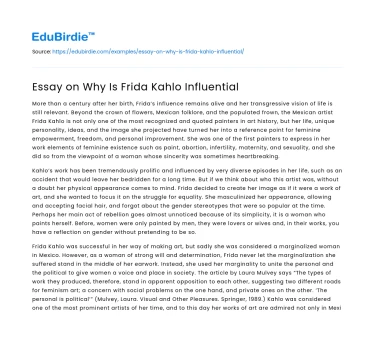More than a century after her birth, Frida’s influence remains alive and her transgressive vision of life is still relevant. Beyond the crown of flowers, Mexican folklore, and the populated frown, the Mexican artist Frida Kahlo is not only one of the most recognized and quoted painters in art history, but her life, unique personality, ideas, and the image she projected have turned her into a reference point for feminine empowerment, freedom, and personal improvement. She was one of the first painters to express in her work elements of feminine existence such as paint, abortion, infertility, maternity, and sexuality, and she did so from the viewpoint of a woman whose sincerity was sometimes heartbreaking.
Kahlo’s work has been tremendously prolific and influenced by very diverse episodes in her life, such as an accident that would leave her bedridden for a long time. But if we think about who this artist was, without a doubt her physical appearance comes to mind. Frida decided to create her image as if it were a work of art, and she wanted to focus it on the struggle for equality. She masculinized her appearance, allowing and accepting facial hair, and forgot about the gender stereotypes that were so popular at the time. Perhaps her main act of rebellion goes almost unnoticed because of its simplicity, it is a woman who paints herself. Before, women were only painted by men, they were lovers or wives and, in their works, you have a reflection on gender without pretending to be so.
Save your time!
We can take care of your essay
- Proper editing and formatting
- Free revision, title page, and bibliography
- Flexible prices and money-back guarantee
Frida Kahlo was successful in her way of making art, but sadly she was considered a marginalized woman in Mexico. However, as a woman of strong will and determination, Frida never let the marginalization she suffered stand in the middle of her earwork. Instead, she used her marginality to unite the personal and the political to give women a voice and place in society. The article by Laura Mulvey says “The types of work they produced, therefore, stand in apparent opposition to each other, suggesting two different roads for feminism art; a concern with social problems on the one hand, and private ones on the other. ‘The personal is political’” (Mulvey, Laura. Visual and Other Pleasures. Springer, 1989.) Kahlo was considered one of the most prominent artists of her time, and to this day her works of art are admired not only in Mexico but throughout the world.






 Stuck on your essay?
Stuck on your essay?

